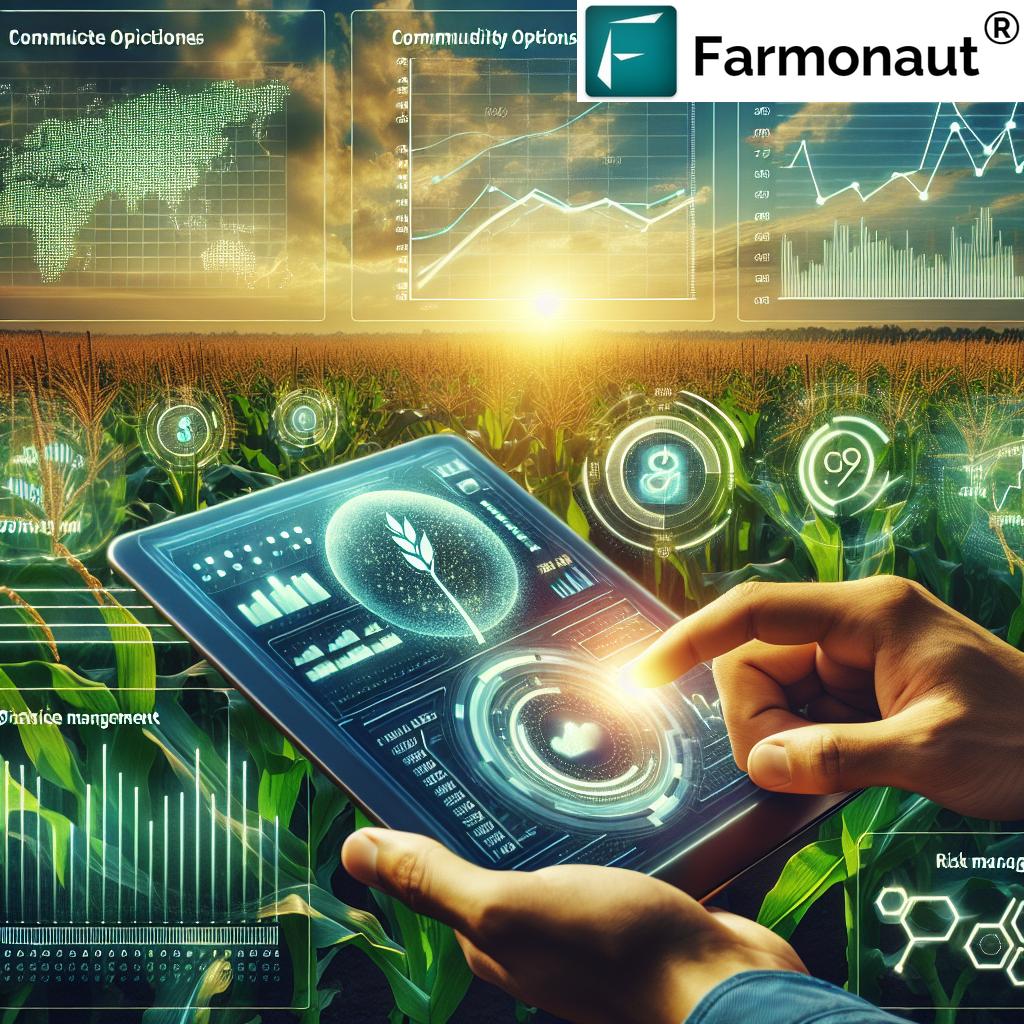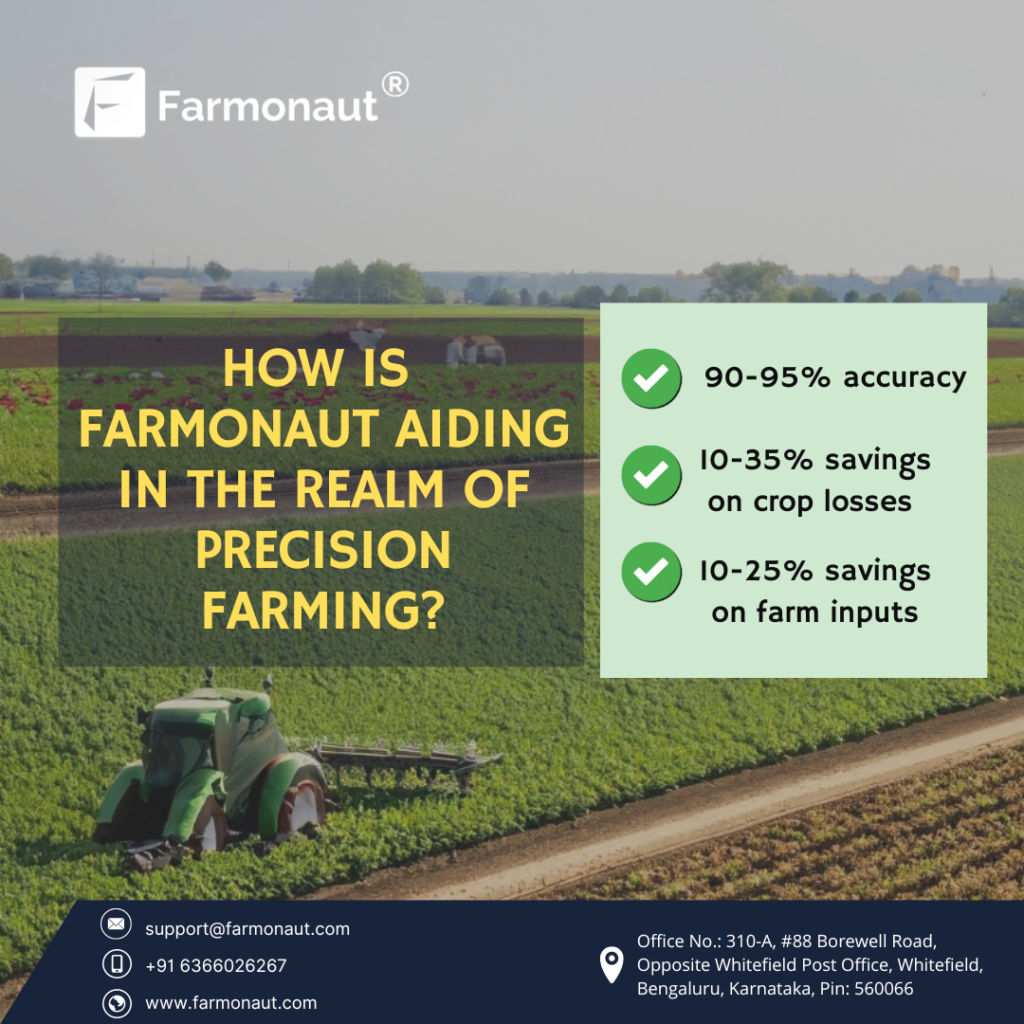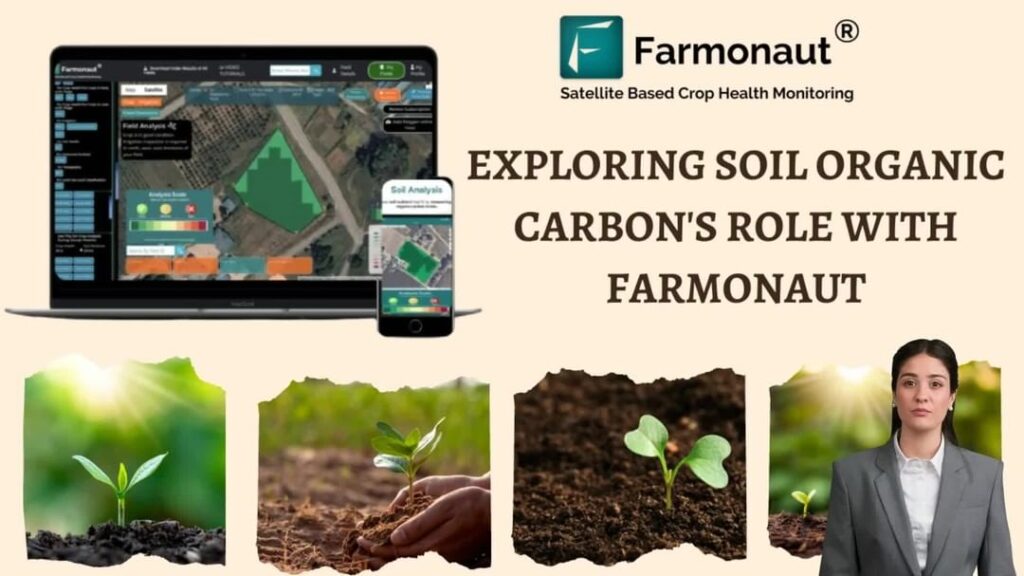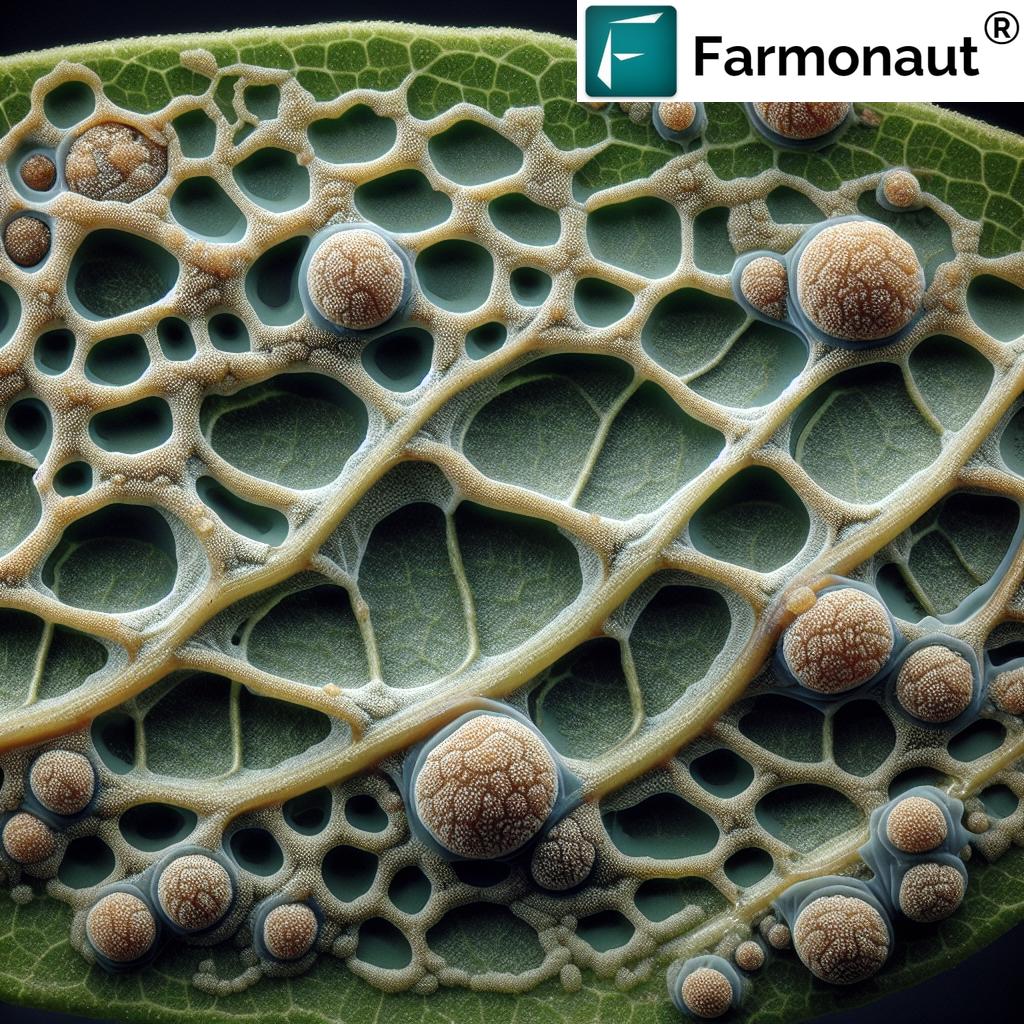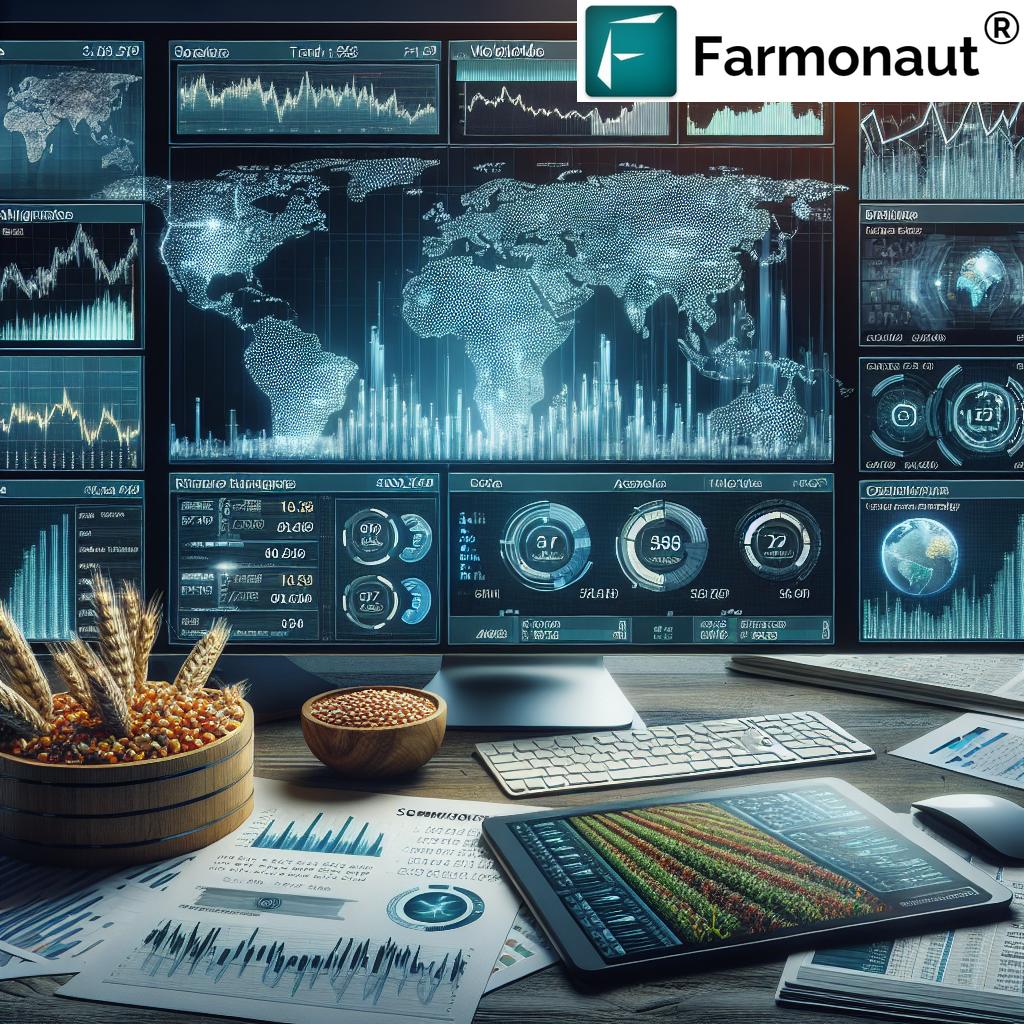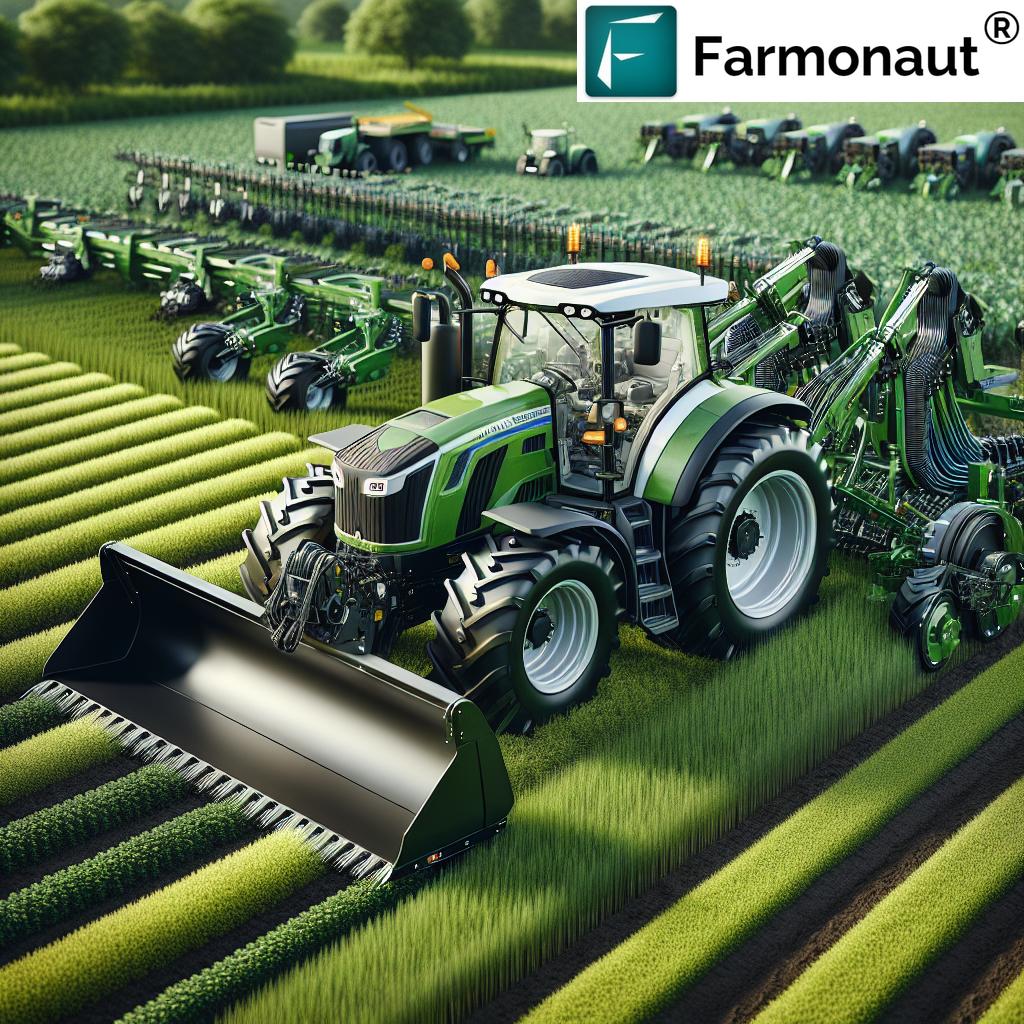Revolutionizing Agriculture: How Digital Solutions and Precision Farming Drive Sustainable Crop Production in North America
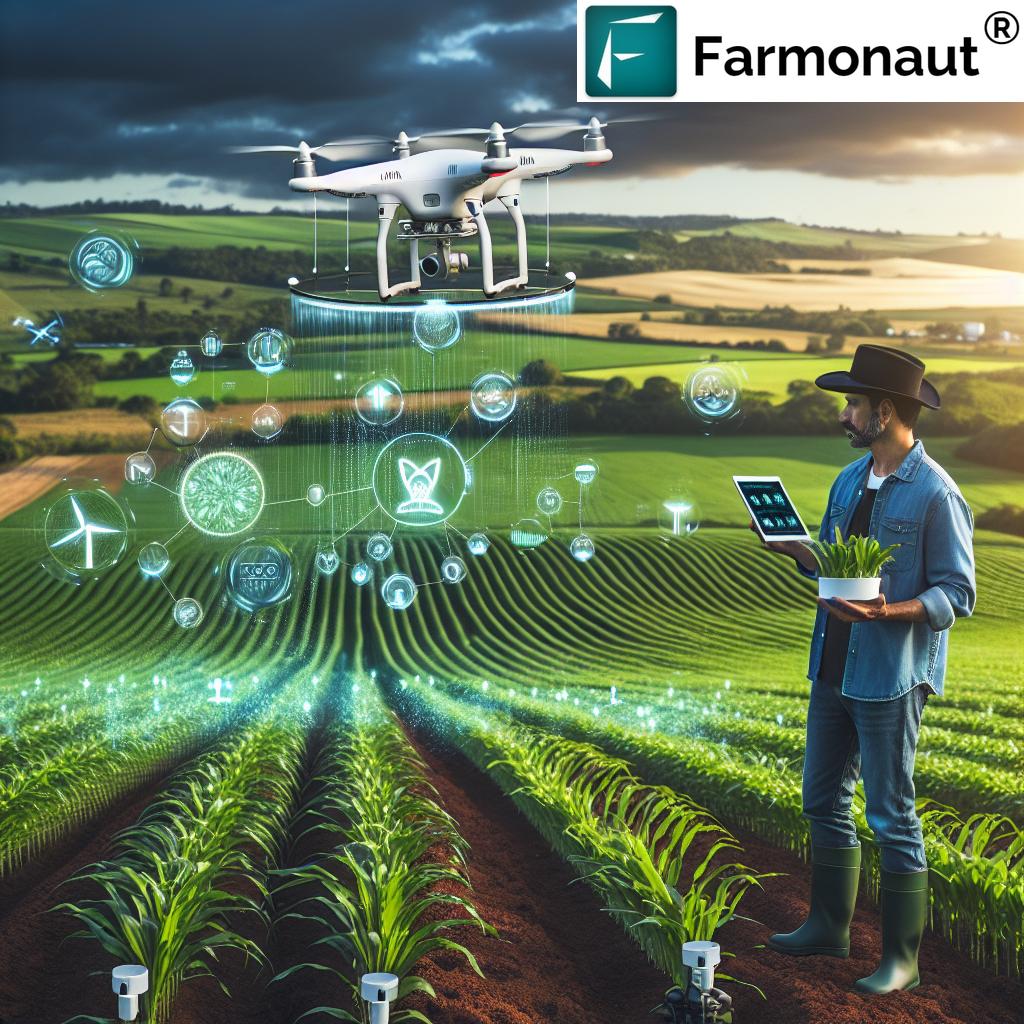
In recent years, we have witnessed a remarkable transformation in the agricultural landscape of North America. The convergence of digital technologies, precision farming techniques, and sustainable practices has ushered in a new era of crop production. As we delve into this agricultural revolution, we’ll explore how innovative solutions are reshaping the way we grow food, manage resources, and protect our environment.
At the forefront of this transformation is the integration of digital agriculture solutions and precision farming technologies. These advancements are not only enhancing agricultural productivity optimization but also promoting climate-smart farming practices that are crucial for the future of our food systems. In this comprehensive exploration, we’ll uncover the multifaceted aspects of this agricultural renaissance, with a particular focus on how companies like Farmonaut are driving innovation in the field.
The Digital Agriculture Revolution
The advent of digital agriculture has fundamentally altered the way we approach farming. By leveraging cutting-edge technologies, we’re now able to make more informed decisions, optimize resource use, and increase overall farm efficiency. Let’s explore some key components of this digital revolution:
1. Satellite-Based Crop Health Monitoring
One of the most significant advancements in digital agriculture is the use of satellite imagery for crop health monitoring. Companies like Farmonaut have pioneered the use of multispectral satellite images to provide farmers with real-time insights into their crops’ health. This technology allows for:
- Early detection of crop stress
- Precise identification of areas requiring attention
- Optimization of irrigation and fertilizer application
- Timely intervention for pest and disease management
By utilizing platforms like Farmonaut’s app, farmers can access this vital information directly from their smartphones, enabling them to make data-driven decisions on the go.
2. AI-Powered Advisory Systems
Artificial Intelligence (AI) has revolutionized farm management by providing personalized, data-driven advice to farmers. These systems analyze vast amounts of data, including:
- Historical crop performance
- Weather patterns
- Soil conditions
- Market trends
By processing this information, AI advisory systems can offer tailored recommendations for crop selection, planting times, and resource allocation. This level of precision helps farmers optimize their operations and increase profitability while reducing environmental impact.
3. Internet of Things (IoT) in Agriculture
The Internet of Things has found a natural home in agriculture, connecting various devices and sensors to create a network of smart farm equipment. IoT devices can monitor:
- Soil moisture levels
- Temperature and humidity
- Equipment performance
- Livestock health and behavior
This interconnected system allows for real-time monitoring and automated responses, greatly improving farm efficiency and reducing manual labor requirements.
Precision Farming: The Future of Agriculture
Precision farming represents a paradigm shift in agricultural practices, moving away from a one-size-fits-all approach to a more targeted, efficient method of crop production. This approach is characterized by:
1. Variable Rate Technology (VRT)
Variable rate technology allows farmers to apply inputs such as fertilizers, pesticides, and seeds at varying rates across a field, based on the specific needs of each area. This precision approach results in:
- Optimized use of resources
- Reduced environmental impact
- Improved crop yields
- Cost savings for farmers
By utilizing VRT, farmers can ensure that each part of their field receives exactly what it needs, no more and no less.
2. GPS-Guided Machinery
Global Positioning System (GPS) technology has revolutionized farm equipment operation. GPS-guided tractors and harvesters can:
- Navigate fields with centimeter-level accuracy
- Reduce overlaps and skips in field operations
- Operate in low-visibility conditions
- Collect precise data on field operations
This level of precision not only improves efficiency but also reduces fuel consumption and soil compaction, contributing to more sustainable farming practices.
3. Drone Technology in Agriculture
Unmanned Aerial Vehicles (UAVs), or drones, have become invaluable tools in precision agriculture. Drones equipped with high-resolution cameras and sensors can:
- Capture detailed imagery of crops
- Monitor plant health and growth stages
- Identify pest infestations and disease outbreaks
- Assist in crop spraying and seeding operations
The data collected by drones can be integrated with other precision farming tools to provide a comprehensive view of field conditions and inform management decisions.
Sustainable Agriculture Practices in the Digital Age
As we embrace digital solutions and precision farming, sustainability remains at the forefront of agricultural innovation. Sustainable agriculture practices are essential for ensuring long-term food security and environmental protection. Let’s explore how digital technologies are supporting these efforts:
1. Soil Health Management
Maintaining soil health is crucial for sustainable crop production. Digital tools and precision farming techniques contribute to soil health by:
- Providing detailed soil composition analysis
- Enabling targeted application of organic matter and nutrients
- Monitoring soil moisture and preventing erosion
- Promoting conservation tillage practices
By leveraging data from satellite imagery and soil sensors, farmers can make informed decisions about soil management, leading to healthier, more productive ecosystems.
2. Water Conservation
Water scarcity is a growing concern in many agricultural regions. Precision irrigation systems, supported by digital technologies, help conserve this precious resource by:
- Delivering water precisely where and when it’s needed
- Adjusting irrigation based on real-time soil moisture data
- Implementing deficit irrigation strategies for water-stressed regions
- Utilizing weather forecasts to optimize irrigation scheduling
These advanced irrigation systems not only save water but also improve crop quality and yield by ensuring optimal moisture levels throughout the growing season.
3. Integrated Pest Management (IPM)
Digital agriculture has revolutionized pest management strategies, allowing for more targeted and environmentally friendly approaches. IPM in the digital age includes:
- Early detection of pest infestations through satellite and drone imagery
- Predictive modeling of pest populations based on weather and crop data
- Precision application of pesticides only where and when needed
- Promotion of biological control methods and natural predators
By reducing reliance on chemical pesticides, these practices help protect biodiversity and promote ecosystem health while maintaining crop productivity.
The Role of Big Data in Agricultural Decision-Making
The agricultural sector is experiencing a data revolution, with vast amounts of information being collected from various sources. Big data analytics is transforming how we approach farming by:
1. Predictive Analytics for Crop Yield
By analyzing historical data, weather patterns, and current crop conditions, predictive analytics can:
- Forecast crop yields with increasing accuracy
- Identify potential risks to crop production
- Optimize harvest timing and logistics
- Inform market strategies and pricing decisions
These insights allow farmers and agribusinesses to make proactive decisions and mitigate risks associated with crop production.
2. Farm Management Software
Comprehensive farm management platforms integrate various data sources to provide a holistic view of farm operations. These software solutions offer:
- Real-time monitoring of field conditions and equipment performance
- Financial management and budgeting tools
- Supply chain management and traceability features
- Compliance tracking for regulatory requirements
By centralizing farm data and operations, these platforms streamline decision-making and improve overall farm efficiency.
3. Machine Learning in Agriculture
Machine learning algorithms are being applied to agricultural data to uncover patterns and insights that might otherwise go unnoticed. Applications include:
- Automated crop and weed identification from images
- Optimization of planting and harvesting schedules
- Predictive maintenance for farm equipment
- Personalized crop variety recommendations based on local conditions
As these algorithms continue to learn and improve, they will play an increasingly important role in agricultural decision-making.
Climate-Smart Farming: Adapting to Environmental Challenges
Climate change poses significant challenges to agriculture, but digital solutions and precision farming are helping farmers adapt and mitigate its effects. Climate-smart farming practices include:
1. Weather Monitoring and Forecasting
Advanced weather stations and predictive models provide farmers with:
- Hyper-local weather forecasts
- Frost and heat stress warnings
- Precipitation predictions for optimal planting and harvesting
- Long-term climate trend analysis for crop selection
This information allows farmers to make timely decisions and implement protective measures when needed.
2. Carbon Sequestration and Emissions Reduction
Digital agriculture is playing a crucial role in efforts to reduce the carbon footprint of farming. Initiatives include:
- Precision application of fertilizers to reduce nitrous oxide emissions
- Promotion of no-till and reduced tillage practices to increase soil carbon storage
- Optimization of livestock management to reduce methane emissions
- Implementation of renewable energy sources on farms
By adopting these practices, farmers can contribute to climate change mitigation while potentially benefiting from carbon credit programs.
3. Crop Diversification and Resilience
Digital tools are helping farmers diversify their crops and build resilience against climate variability by:
- Identifying climate-adapted crop varieties
- Simulating crop performance under different climate scenarios
- Optimizing crop rotations for soil health and pest management
- Facilitating the adoption of agroforestry and intercropping systems
These strategies help farmers reduce risk and maintain productivity in the face of changing environmental conditions.
The Future of Sustainable Crop Protection
As we move towards more sustainable agricultural practices, crop protection strategies are evolving to minimize environmental impact while maintaining crop health. The future of crop protection includes:
1. Biological Pest Control
Digital technologies are enhancing the effectiveness of biological pest control methods by:
- Mapping beneficial insect populations and habitats
- Optimizing the release of natural predators
- Monitoring the effectiveness of biological control agents
- Integrating biological control with other IPM strategies
These approaches reduce reliance on chemical pesticides and promote ecosystem balance.
2. Precision Spraying Technologies
Advanced spraying systems use digital mapping and real-time sensing to:
- Target pesticide application only to affected areas
- Adjust spray volume and droplet size based on crop canopy
- Avoid spraying in buffer zones and sensitive areas
- Record and track all spraying activities for compliance and optimization
These precision techniques significantly reduce pesticide use and environmental contamination.
3. Gene Editing and Biotechnology
While controversial, gene editing technologies like CRISPR are being explored for their potential to:
- Develop crop varieties with enhanced disease resistance
- Improve crop tolerance to environmental stresses
- Enhance nutritional content of food crops
- Reduce the need for chemical inputs in agriculture
As these technologies advance, they may play a significant role in sustainable crop protection strategies.
The Economic Impact of Digital Agriculture and Precision Farming
The adoption of digital agriculture solutions and precision farming technologies is having a profound economic impact on the agricultural sector. Some key economic benefits include:
1. Increased Farm Profitability
By optimizing inputs and improving yields, digital agriculture can significantly enhance farm profitability through:
- Reduced waste of fertilizers, pesticides, and water
- Improved crop quality, leading to higher market prices
- Lower labor costs through automation and efficiency gains
- Better risk management and reduced crop losses
These factors contribute to a more sustainable and profitable agricultural sector.
2. New Revenue Streams
Digital agriculture is opening up new opportunities for farmers to diversify their income sources, including:
- Data monetization through sharing of farm data with researchers and companies
- Participation in carbon credit markets through sustainable farming practices
- Development of value-added products through precision agriculture techniques
- Offering precision farming services to other farmers
These additional revenue streams can help stabilize farm incomes and promote rural economic development.
3. Supply Chain Optimization
Digital technologies are improving agricultural supply chains by:
- Enhancing traceability from farm to consumer
- Reducing food waste through better forecasting and inventory management
- Improving logistics and transportation efficiency
- Facilitating direct-to-consumer marketing for small-scale farmers
These improvements benefit both farmers and consumers while reducing the environmental impact of food production and distribution.
The Role of Agricultural Research and Development
Continued investment in agricultural research and development is crucial for driving innovation and addressing the challenges facing modern agriculture. Key areas of focus include:
1. Crop Breeding and Genetics
Advanced breeding techniques, supported by digital technologies, are accelerating the development of improved crop varieties with:
- Enhanced yield potential
- Improved nutritional profiles
- Greater resistance to pests and diseases
- Increased tolerance to environmental stresses
These advancements are essential for ensuring food security in the face of climate change and population growth.
2. Agtech Innovations
The agtech sector is rapidly evolving, with new technologies emerging to address various agricultural challenges. Areas of innovation include:
- Advanced sensors and IoT devices for real-time monitoring
- Robotics and autonomous systems for farm operations
- Blockchain technology for supply chain transparency
- Vertical farming and controlled environment agriculture
These innovations are reshaping the agricultural landscape and creating new opportunities for sustainable food production.
3. Collaborative Research Initiatives
Partnerships between academia, industry, and government are driving agricultural innovation through:
- Large-scale field trials to validate new technologies
- Open data initiatives to share research findings
- Interdisciplinary research combining agriculture with other fields like computer science and engineering
- Farmer-participatory research to ensure relevance and adoption of new practices
These collaborative efforts are essential for addressing complex agricultural challenges and promoting sustainable development.
Comparative Analysis: Traditional vs. Precision Farming with Farmonaut Satellite System
| Agricultural Aspect | Traditional Farming | Precision Farming with Farmonaut |
|---|---|---|
| Crop Health Monitoring | Periodic visual inspections | Real-time satellite imagery analysis |
| Soil Fertility Management | Uniform application of fertilizers | Variable rate fertilizer application based on soil analysis |
| Yield Prediction | Based on historical data and experience | AI-driven crop yield prediction models |
| Resource Optimization | Generalized resource allocation | Precise resource management using satellite data |
| Sustainability | Limited environmental considerations | Integrated sustainability practices and carbon footprint tracking |
This table clearly illustrates the significant advantages that precision farming with Farmonaut’s satellite system offers over traditional farming methods. By leveraging advanced technologies, Farmonaut enables farmers to make more informed decisions, optimize resource use, and implement sustainable practices that benefit both the environment and their bottom line.
Frequently Asked Questions
To address some common queries about digital agriculture and precision farming, we’ve compiled a list of frequently asked questions:
1. What is precision agriculture?
Precision agriculture is a farming management concept that uses digital technologies to monitor and optimize crop production processes. It involves collecting and analyzing data to make more accurate and timely decisions about planting, fertilizing, irrigating, and harvesting crops.
2. How does satellite imagery help in farming?
Satellite imagery provides farmers with a bird’s-eye view of their fields, allowing them to monitor crop health, detect issues early, and make informed decisions about resource allocation. It’s particularly useful for large-scale operations where ground-based monitoring would be time-consuming and inefficient.
3. What is variable rate technology (VRT)?
Variable rate technology is a method of applying farm inputs (such as fertilizers, seeds, or pesticides) at varying rates across a field, according to the specific needs of each area. This precision approach optimizes resource use and can improve crop yields while reducing environmental impact.
4. How does AI contribute to agriculture?
AI in agriculture helps analyze vast amounts of data from various sources to provide insights and recommendations. It can predict crop yields, detect plant diseases, optimize irrigation, and even control autonomous farm equipment.
5. What are the benefits of using farm management software?
Farm management software helps farmers streamline operations, track expenses and revenues, manage inventory, plan crop rotations, and make data-driven decisions. It can significantly improve farm efficiency and profitability.
6. How does precision farming contribute to sustainability?
Precision farming promotes sustainability by optimizing resource use, reducing waste, minimizing environmental impact, and improving soil health. It allows farmers to produce more food with fewer inputs, contributing to long-term agricultural sustainability.
7. What is the role of drones in precision agriculture?
Drones equipped with cameras and sensors can capture high-resolution imagery of crops, monitor plant health, identify pest infestations, and even assist in targeted spraying operations. They provide a flexible and cost-effective way to gather detailed field data.
8. How can small-scale farmers benefit from digital agriculture?
Small-scale farmers can benefit from digital agriculture through smartphone apps that provide weather forecasts, pest alerts, and market information. They can also use affordable sensors for soil moisture monitoring and access satellite imagery services like Farmonaut for crop health insights.
9. What is the future of agriculture technology?
The future of agriculture technology is likely to involve increased automation, more sophisticated AI and machine learning applications, advanced biotechnology, and greater integration of data from various sources to create holistic farm management systems.
10. How does Farmonaut contribute to precision farming?
Farmonaut provides satellite-based crop health monitoring, AI-driven advisory systems, and resource management tools that enable farmers to implement precision farming techniques. Their platform makes advanced agricultural technologies accessible and affordable for farmers of all scales.
Conclusion: Embracing the Future of Agriculture
As we’ve explored throughout this article, the integration of digital solutions and precision farming technologies is fundamentally transforming agriculture in North America and beyond. From satellite-based crop monitoring to AI-powered decision support systems, these innovations are driving sustainable crop production and helping farmers meet the challenges of the 21st century.
The benefits of this agricultural revolution are clear:
- Increased productivity and efficiency
- Improved resource management and sustainability
- Enhanced crop quality and yield stability
- Greater resilience to climate change and environmental stresses
- New economic opportunities for farmers and rural communities
As we look to the future, it’s evident that the continued development and adoption of digital agriculture solutions will be crucial for ensuring food security, protecting our environment, and supporting the livelihoods of farmers around the world.
Companies like Farmonaut are at the forefront of this agricultural transformation, making advanced technologies accessible to farmers of all sizes. By leveraging satellite imagery, AI, and data analytics, Farmonaut is empowering farmers to make more informed decisions and implement sustainable practices that benefit both their operations and the planet.
We encourage all stakeholders in the agricultural sector – from individual farmers to policymakers and researchers – to embrace these innovative technologies and contribute to the ongoing evolution of farming practices. By working together and leveraging the power of digital solutions, we can create a more sustainable, productive, and resilient agricultural future for generations to come.
To learn more about how you can implement precision farming technologies on your farm, explore Farmonaut’s range of solutions:
- Farmonaut Mobile App for on-the-go crop monitoring
- Farmonaut API for integrating satellite data into your existing systems
- Farmonaut on Google Play for Android users
- Farmonaut on the App Store for iOS users
- Farmonaut API Documentation for developers looking to build on our platform
Take the first step towards revolutionizing your farming practices today and join the precision agriculture movement with Farmonaut.
Subscribe to Farmonaut Services
Ready to transform your farming operations with cutting-edge digital solutions? Subscribe to Farmonaut’s services and gain access to powerful tools for crop monitoring, decision support, and sustainable farm management.
By subscribing to Farmonaut, you’re not just investing in your farm’s productivity – you’re joining a community of forward-thinking farmers committed to sustainable agriculture and innovation. Start your journey towards precision farming excellence today!




